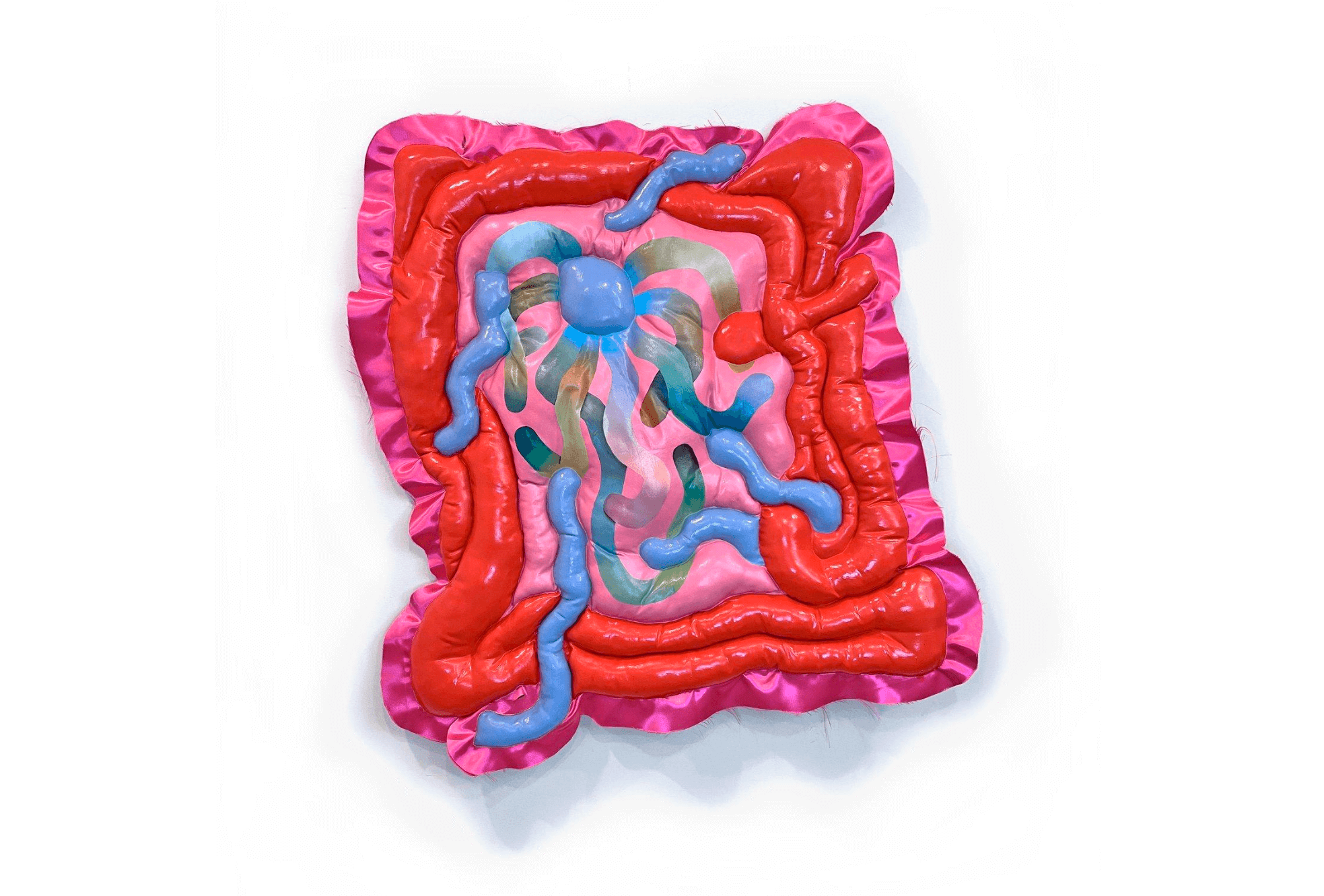There are few things more seductive than a cocoon. A silky encasement, plump from sheltering a mysterious, metamorphosing interior, the cocoon’s allure stems from the sense of something hidden, but also from its emphatic material presence: its ripeness, its bulging form, its proximity to a possible emergence. The artworks featured in “STUFFED” entice with a similar charm. The third collaborative curatorial project undertaken by friends Mallory A. Ruymann and Leah Triplett Harrington, this exhibition transforms Boston University’s Fay G., Jo, and James Stone Gallery into a surrealistic wonderland, somewhere between a down duvet and a padded cell. Puffy patchwork textiles and uncanny soft sculpture assemblages constellate with wall-mounted works that appear inflated, swollen with puckered seams. Each object enchants, appealing to tactility and the interrelated experiences of texture and affect, while still withholding, occluding, and obscuring their indiscernible insides.
Online Only• Sep 14, 2023
Pillow Talk: Intimacy and Animacy in “STUFFED”
Puffy patchwork textiles, uncanny soft sculpture assemblages, and wall-mounted works that appear inflated transform one of Boston University’s galleries into a surrealistic and wonderland, where each object enchants.
Review by Kendall DeBoer
(left) Meg Lipke, "Big Pink," 2020. acrylic on canvas with polyester fill. 108″ x 133″ x 15″. (right) Maria A. Guzmán Capron, "Doble," 2022. Fabric, thread, batting, stuffing, spray paint, latex paint. 70 ¼″ x 68″. Installation view, “STUFFED,” Boston University Art Galleries. On view through September 15, 2023. Photo courtesy of Boston University Art Galleries. Photo by Mel Taing.

(left) Meg Lipke, "Big Pink," 2020. acrylic on canvas with polyester fill. 108″ x 133″ x 15″. (right) Maria A. Guzmán Capron, "Doble," 2022. Fabric, thread, batting, stuffing, spray paint, latex paint. 70 ¼″ x 68″. Installation view, “STUFFED,” Boston University Art Galleries. On view through September 15, 2023. Photo courtesy of Boston University Art Galleries. Photo by Mel Taing.

Installation view, “STUFFED,” Boston University Art Galleries, with works by Rose Nestler and Natalie Baxter. On view through September 15, 2023. Photo courtesy of Boston University Art Galleries. Photo by Mel Taing.
These works are cocoon-like, but they’re also person-like—or even puppet-like. I say puppet-like not to diminish their spirited, living quality, but rather to point to their strangeness, potency, and magic. Puppets are “characters human and inhuman, close to objects … What looks like a bundle of rags, a thin silhouette of perforated leather, assumes a voice and a personality.” (1) Likewise, soft materials in “STUFFED” have temperaments, dispositions, and stories to share. Some works are deliberately representational, like Maria A. Guzmàn Capron’s embracing figures, L’Merchie Frazier’s quilted portraits, and Nastassja E. Swift’s felted faces.

Amelia Briggs, Fuss, 2023. Fiber, silk, latex, acrylic, oil. Photography courtesy of the artist. © Amelia Briggs.
Yet identifiable human beings are not prerequisite for anthropomorphism. Amelia Briggs’s lacquered silk-and-latex biomorphic shapes are stuffed with fiber, but I would readily believe they contain organic matter. Fuss (2023) could be a blood bag. Kelp (2023) looks juicy, like a chrysalis containing a liquified caterpillar suspended in fluids. Ruymann and Triplett Harrington write: “Like blown-up, abstracted cartoon figures, Briggs’s work playfully recalls the body.” More abstracted, installation-oriented works, like Jai Hart’s polyfill extrusions and Meg Lipke’s Big Pink (2020), slouch, bend, and stretch as if fleshly, corporeal. The palpable energy of the works’ personae makes sense, given that the prelude to the exhibition anchors the show in a highly expressive historic painting by Elizabeth Murray depicting a woman applying lipstick.

BSisters Khaleghi, Lunch, 2019. Installation view, “STUFFED,” Boston University Art Galleries. On view through September 15, 2023. Photo courtesy of Boston University Art Galleries. Photo by: Mel Taing.
In their curatorial statement, Ruymann and Triplett Harrington remind us that “the artists presented here make in ways that defy category.” This anti-categorical mode suits the pliability of textiles, fiber arts, and craft-inflected artmaking, ever-apparent in the haptic hanging of this exhibition and its intimate, textural, shapeshifting objects. This framework also complements the cocoon and the puppet, both of which occupy a liminal, ambiguous position. They also share linguistic roots: “The word [puppet] derives from the Latin pupa, for little girl or doll, a word still used in entomology to describe the mysterious, more passive middle stage of an insect’s metamorphosis, as the larva is covered in a chrysalis, and awaits reemergence as a winged thing.” (2) I find this doubling poetic, and apt for navigating the shifting, eerie forms in “STUFFED.” I think of Rose Nestler’s Ballet Bag’s (2021) thick, packed duffle hatching like an egg to reveal two pert pink leather legs; I imagine myself circling the mixed-media, tangled amalgamation of BSisters Khaleghi’s Lunch (2019) to view filler extruding from distended limbs; I recall the tender posture of Courtney Stock’s child, a diminutive wool and silk sculpture situated on a shelf low to the ground. Each example exudes emotional and material presence, enfolds and envelopes, expands and expresses, resulting in an exhibition experience that is charming, peculiar, and generative.

Installation view, “STUFFED,” Boston University Art Galleries, with works by Courtney Stock and Khadija Aziz. On view through September 15, 2023. Photo courtesy of Boston University Art Galleries. Photo by Mel Taing.
1. Kenneth Gross, Puppet: An Essay on Uncanny Life (Chicago: The University of Chicago Press, 2011), 3.
2. Ibid., 3.
“STUFFED” is on view at Boston University’s Faye G., Jo, and James Stone Gallery through September 15, 2023.
